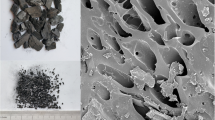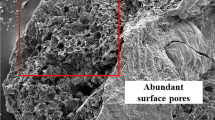Abstract
Green roof is known to minimize urban waterlogging owing to its water retention capacity due to the presence of substrate soil layer. Biochar, which is a carbon-negative material, appears to be an essential soil amendment in green roof due to its water-holding capacity and stability. Recently, incentives are provided in developed countries to enhance commercial production of biochar for usage in green infrastructure, with an aim to meet carbon reduction goals of 2030. Further, biochar has a longer half-life (over 100 years), compared to other materials that are easier to degrade. In this study, the influence of different biochar contents on hydrological performance of green roof is evaluated using a combination of experiment and numerical simulation. Four soil columns with different biochar contents (0, 5, 10 and 15%) were subjected to artificial rainfall. Hydraulic parameters were obtained using inverse solution from the collected rainfall data. Numerical simulations were used to explore the impact of different biochar contents on green roof rainwater management performance during real rainfall process. Biochar is found to enhance saturated water content and, however, tends to reduce saturated hydraulic conductivity. The green roof with 10% BAS (10% biochar content) has better ability of comprehensive rainwater management, with the highest peak outflow reduction and the longest rainwater outflow delay. Green roof with 5% BAS has highest runoff reduction and longest peak outflow delay. These results provide a suitable selection of biochar content for urban areas with different rainwater management requirements.








Similar content being viewed by others
References
ASTM (2011) D2487–11–2011 Standard practice for classification of soils for engineering purposes (Unified Soil Classification System). Developed by Subcommittee: D18.07 Book of Standards Volume:04.08
Abrol V, Ben-Hur M, Verheijen FGA, Keizer JJ, Martins MAS, Tenaw H, Tchehansky L, Graber ER (2016) Biochar effects on soil water infiltration and erosion under seal formation conditions: rainfall simulation experiment. J Soils Sedim 16(12):2709–2719
Anangsha A, Gadi VK, Bordoloi S, Kothapalli SK, Sreedeep S, Guoxiong M, Garg A (2019) A new autonomous program customized for computing surface cracks in an unsaturated soil in a 1D column. J Test Eval 47(5):3822–3835
Beck DA, Johnson GR, Spolek GA (2011) Amending green roof soil with biochar to affect runoff water quantity and quality. Environ Pollut 159(8–9):2111–2118
Berretta C, Poë S, Stovin V (2014) Reprint of “moisture content behaviour in extensive green roofs during dry periods: the influence of vegetation and substrate characteristics.” J Hydrol 516:37–49
Bieser JMH, Thomas SC (2019) Biochar and high-carbon wood ash effects on soil and vegetation in a boreal clearcut. Can J for Res 49(9):1124–1134
Bordoloi S, Garg A, Sreedeep S et al (2018) Investigation of cracking and water availability of soil-biochar composite synthesized from invasive weed water hyacinth. Biores Technol 263:665–677
Bus A, Karczmarczyk A, Baryla A (2016) The use of reactive material for limiting P-leaching from green roof substrate. Water Sci Technol 73(12):3027–3032
Cao CTN, Farrell C, Kristiansen PE, Rayner JP (2014) Biochar makes green roof substrates lighter and improves water supply to plants. Ecol Eng 71:368–374
Chen HM, Du XF, Lai MQ et al (2021) Biochar improves sustainability of green roofs via regulate of soil microbial communities. Agriculture 11(7):620
Chen H, Ma J, Wei J, Gong X, Yu X, Guo H, Zhao Y (2018) Biochar increases plant growth and alters microbial communities via regulating the moisture and temperature of green roof substrates. Sci Total Environ 635:333–342
Di-Prima S, Castellini M, Abou-Najm MR, Stewart RD, Angulo-Jaramillo R, Winiarski T, Lassabatere L (2019) Experimental assessment of a new comprehensive model for single ring infiltration data. J Hydrol 573:937–951
FLL (2002) Guideline for the planning, execution and upkeep of green-roof sites. Landscaping Development Research Society, Germany
Garg A, Bordoloi S, Ni J, Cai W, Maddibiona PG, Mei G, Poulsen TG, Lin P (2019) Influence of biochar addition on gas permeability in unsaturated soil. Géotech Lett 9(1):66–71
Garg A, Huang H, Kushvaha V et al (2020) Mechanism of biochar soil pore-gas-water interaction: Gas properties of biochar-amended sandy soil at different degrees of compaction using KNN modeling. Acta Geophys 68(1):207–217
Gopal P, Bordoloi S, Ratnam R, Lin P, Cai W, Buragohain P, Garg A, Sreedeep S (2019) Investigation of infiltration rate for soil-biochar composites of water hyacinth. Acta Geophys 67(1):231–246
Gregoire BG, Clausen JC (2011) Effect of a modular extensive green roof on stormwater runoff and water quality. Ecol Eng 37(6):963–969
Hemath M, Rangappa SM, Kushvaha V et al (2020) A comprehensive review on mechanical, electromagnetic radiation shielding, and thermal conductivity of fibers/inorganic fillers reinforced hybrid polymer composites. Polym Compos 41(10):3940–3965
Hilten RN, Lawrence TM, Tollner EW (2008) Modeling stormwater runoff from green roofs with HYDRUS-1D. J Hydrol 358(3–4):288–293
Huang H, Cai WL, Zheng Q et al (2020) Gas permeability in soil amended with biochar at different compaction states. IOP Conf Ser: Earth Environ Sci 463:012073
Jha RK, Sahoo B, Panda RK (2017) Modeling the water and nitrogen transports in a soil-paddy-atmosphere system using HYDRUS-1D and lysimeter experiment. Paddy Water Environ 15:831–846
Jin C, Bai X, Luo T, Zou M (2018) Effects of green roofs variations on the regional thermal environment using measurements and simulations in Chongqing, China. Urban for Urban Green 29:223–237
Kelleners TJ, Soppe RWO, Ayars JE, Šimůnek J, Skaggs TH (2005) Inverse analysis of upward water flow in a groundwater table lysimeter. Vadose Zone J 4(3):558–572
Kumar H, Ganesan SP, Bordoloi S et al (2019) Erodibility assessment of compacted biochar amended soil for geo-environmental applications. Sci Total Environ 672:698–707
Kuoppamäki K, Lehvävirta S (2016) Mitigating nutrient leaching from green roofs with biochar. Landsc Urban Plan 152:39–48
Lehmann J (2007) Bio-energy in the black. Front Ecol Environ 5(7):381–387
Lim TJ, Spokas KA, Feyereisen G, Novak JM (2016) Predicting the impact of biochar additions on soil hydraulic properties. Chemosphere 142:136–144
Marquardt DW (1963) An algorithm for least-squares estimation of nonlinear parameters. J Soc Ind Appl Math 11(2):431–441
Meng RF, Zhang QQ, Li DS et al (2021) Influence of substrate layer thickness and biochar on the green roof capacity to intercept rainfall and reduce pollution in runoff. Pol J Environ Stud 30(5):4085–4103
Mohawesh O, Durner W (2019) Effects of bentonite, hydrogel and biochar amendments on soil hydraulic properties from saturation to oven dryness. Pedosphere 29(5):598–607
Mualem Y (1976) A new model for predicting the hydraulic conductivity of unsaturated porous media. Water Resour Res 12(3):513–522
Ni JJ, Chen XW, Ng CWW, Guo HW (2018) Effects of biochar on water retention and matric suction of vegetated soil. Géotech Lett 8(2):124–129
Pardo GS, Sarmah AK, Orense RP (2018) Mechanism of improvement of biochar on shear strength and liquefaction resistance of sand. Géotechnique 17:040
Qiu DY, Peng HY, Li T et al (2020) Application of stabilized sludge to extensive green roofs in Shanghai: feasibility and nitrogen leaching control. Sci Total Environ 732:138898
Quinn R, Dussaillant A (2018) The impact of macropores on heavy metal retention in sustainable drainage systems. Hydrol Res 49(2):517–527
Rasa K, Heikkinen J, Hannula M et al (2018) How and why does willow biochar increase a clay soil water retention capacity? Biomass Bioenerg 119:346–353
Rukhaiyar S, Huang S, Song H, Lin P, Garg A, Bordoloi S (2019) A new intelligent model for computing crack in compacted soil-biochar mix: application in green infrastructure. Geotech Geol Eng 38(1):201–214
Šimunek J et al (2008) The Hydrus-1D software package for simulating the movement of water, heat, and multiple solutes in variably saturated media, Version 4.0, HYDRUS Software Series 3. Department of Environmental Sciences, University of California Riverside, Riverside, CA
Vinod A, Gowda TGY, Vijay R et al (2021) Novel Muntingia Calabura bark fiber reinforced green-epoxy composite: a sustainable and green material for cleaner production. J Clean Prod 294:126337
Wang H, Garg A, Huang S, Mei GX (2020a) Mechanism of compacted biochar-amended expansive clay subjected to drying-wetting cycles: simultaneous investigation of hydraulic and mechanical properties. Acta Geophys 68(3):737–749
Wang H, Garg A, Zhang XY, Mei GX (2021) Utilization of coconut shell residual in green roof: hydraulic and thermal properties of expansive soil amended with biochar and fibre including theoretical model. Acta Geophys 68(6):1803–1819
Wang SL, Tzou YM, Lu YH et al (2007) Removal of 3-chlorophenol from water using rice-straw-based carbon. J Hazard Mater 147(S1/2):313–318
Wang H, Zhang KX, Gan L, et al. (2020) Expansive soil-biochar-root-water-bacteria interaction: Investigation on crack development, water management and plant growth in green infrastructure. International Journal of Damage Mechanics 0(0):1–23
Wani I, Kumar H, Rangappa SM et al (2021) Multiple regression model for predicting cracks in soil amended with pig manure biochar and wood biochar. J Hazard Toxic Radioact Waste 25(1):04020061
Wani I, Ramola S, Garg A et al (2021) Critical review of biochar applications in geoengineering infrastructure: moving beyond agricultural and environmental perspectives. Biomass Conv Biorefinery. https://doi.org/10.1007/s13399-021-01346-8
Wani I, Sharma A, Kushvaha V et al (2020) Effect of pH, volatile content, and pyrolysis conditions on surface area and O/C and H/C ratios of biochar: towards understanding performance of biochar using simplified. J Hazard Toxic Radioact Waste 24(4):04020048
Wong JTF, Chen Z, Ng CWW et al (2016) Gas permeability of biochar amended clay: potential alternative landfill final cover material. Environ Sci Pollut Res Int 23(8):7126–7131
Wong JTF, Chen ZK, Ng CWW, Wong MH (2015) Gas permeability of biochar-amended clay: potential alternative landfill final cover material. Environ Sci Pollut Res 23(8):712–7131
Yang WY, Li D, Sun T, Ni GH (2015) Saturation-excess and infiltration-excess runoff on green roofs. Ecol Eng 74:327–336
Zheng C, Lu Y, Guo X et al (2017) Application of HYDRUS-1D model for research on irrigation infiltration characteristics in aridoasis of northwest China. Environ Earth Sci 76:785
Acknowledgements
The authors would like to express their sincere gratitude to National Natural Science Foundation of China (Grant No. 51878185) and Innovative Research Team Program of Guangxi Natural Science Foundation (Grant No. 2016GXNSFGA380008) for support.
Funding
This study was supported by the National Natural Science Foundation of China (Grant No.51878185) and Innovative Research Team Program of Guangxi Natural Science Foundation (Grant No. 2016GXNSFGA380008).
Author information
Authors and Affiliations
Corresponding author
Ethics declarations
Conflicts of interest
All authors declare that there is no conflict of interest.
Availability of data and material
The data that support the findings of this study are available from the corresponding.
Code availability
The software HYDRUS-1D is an open source code which is available online (www.pc-progress.com).
Ethical approval
This paper does not contain any studies with human participants or animals performed by any of the authors.
Additional information
Communicated by Dr. Michael Nones (CO-EDITOR-IN-CHIEF).
Rights and permissions
About this article
Cite this article
Gan, L., Garg, A., Wang, H. et al. Influence of biochar amendment on stormwater management in green roofs: experiment with numerical investigation. Acta Geophys. 69, 2417–2426 (2021). https://doi.org/10.1007/s11600-021-00685-4
Received:
Accepted:
Published:
Issue Date:
DOI: https://doi.org/10.1007/s11600-021-00685-4




